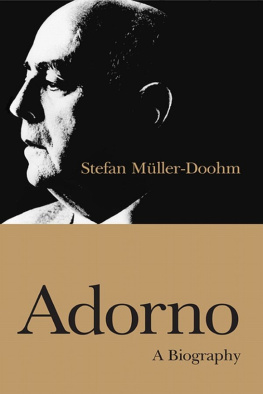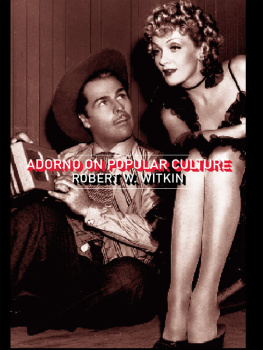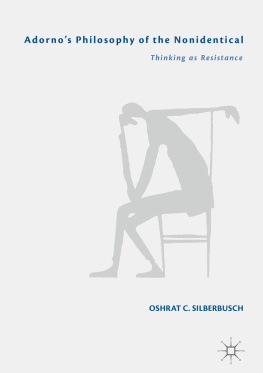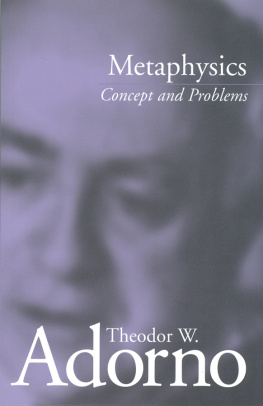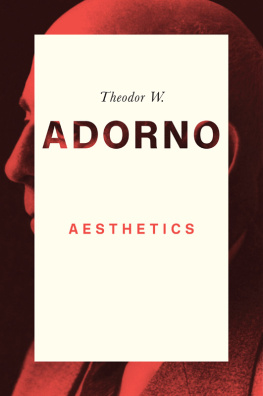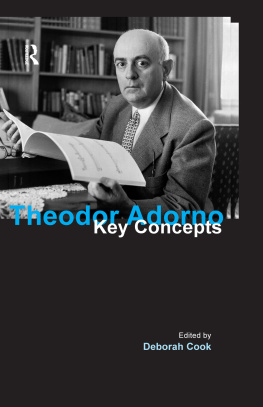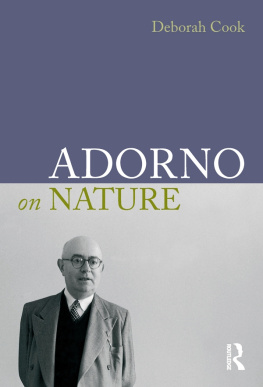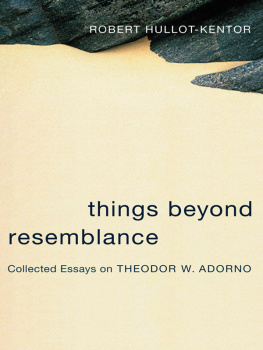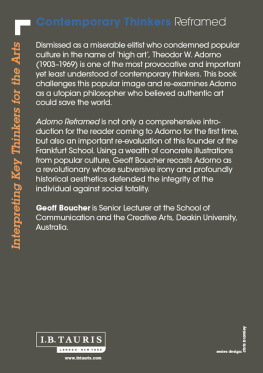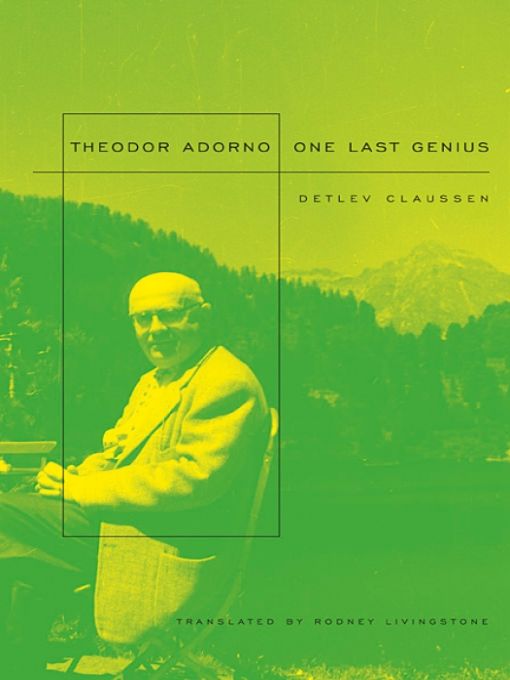
Table of Contents
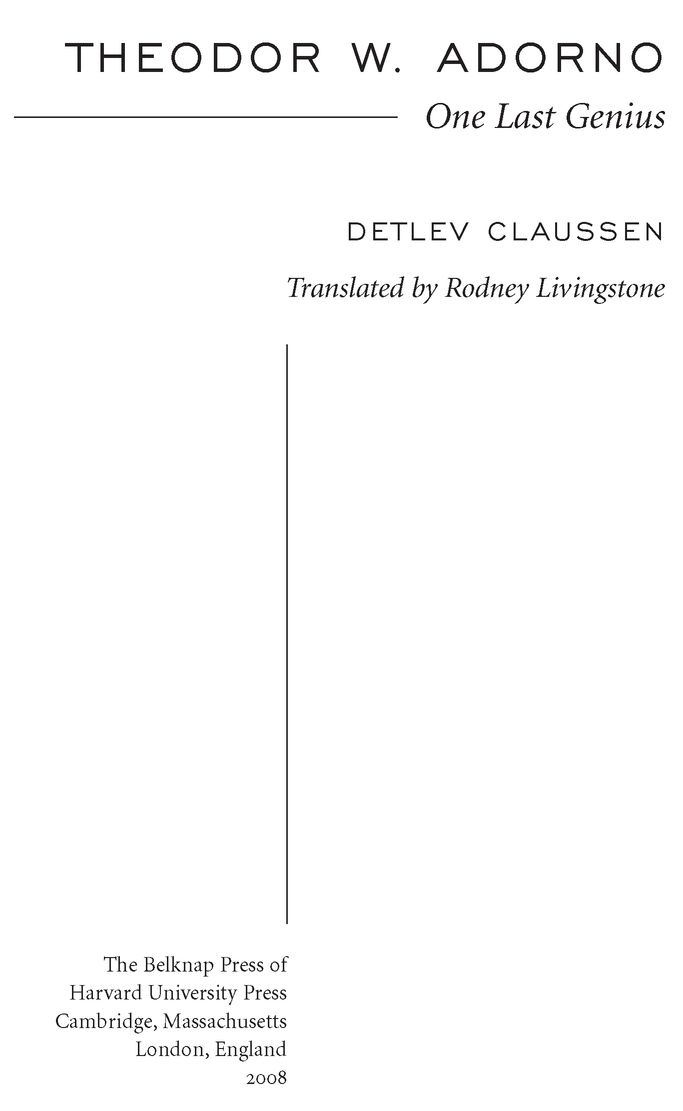
For my mother-in-law, Erna Leszczyska, and my mother, Carla Claussen, both of whom have helped me to understand the twentieth century through experience.
How to Read This Book
The aim of this book is to help Adornos texts speak for themselves and emerge in their original form from behind the secondary literature that has proliferated endlessly. Each chapter is designed so that it can also be read on its own. Adornos works are interpreted as a palimpsest, works full of overlapping ideas. References to all sources cited in the text can be found by those who wish to inspect them critically, or extend their reading, in the endnotes or at the end of the book under the heading Sources.
Like most so-called child prodigies, I am a very late developer and I still feel today that whatever I truly exist for still lies before me.
THEODOR W. ADORNO TO ERNST BLOCH, 26 JULY 1962
I feel very strongly that in my case work is a drug that helps me to overcome what would otherwise be an almost unbearable melancholy and loneliness. I fear that this is the secret of my so-called productivity.
31 MARCH 1960, NOTEBOOK F
... and conceive the better state as one in which people could be differentwithout fear.
MINIMA MORALIA 1945
Instead of an Overture: No Heirs
The news of his death came suddenly and quite unexpectedly. People had just started to breathe freely again in Frankfurt after a turbulent summer semester. In mid-July 1969 Theodor Adorno and his wife, Gretel, had escaped from the usual sultry Frankfurt summer heat and, as he had done for the previous two decades, withdrawn to the Swiss mountains like old mountain cattle changing their pasture. Even at this distance he was able to deal with essential administrative matters and correspondence. On Wednesday, 6 August, a letter to Herbert Marcuse was being typed up in the office of the Institute for Social Research. The secretarial staff were waiting for alterations and a final approval from Zermatt. After a phone call to the Hotel Bristol, Adornos secretary in Frankfurt, Hertha Georg, was told that Herr Professor had gone to the hospital. It sounded to her as if this was nothing more than an excursion to the Magic Mountain. But toward noon, definitive word arrived in Frankfurt from Gretel Adorno. By Saturday a death notice signed by her appeared in the Frankfurter Rundschau, stating simply, Theodor W. Adorno, born on 11 September 1903, died quietly in his sleep on 6 August 1969.
The German public was quite unprepared for the news of Adornos death in Switzerland. The obituaries lying in the file drawers of newspaper editors had not been updated. Most of the people who might have been entrusted with the task of writing a fresh one were on vacation. Unusually, no one rushed to the fore to make a public comment. The stormy political quarrels with his students that Adorno had endured in 1969 seemed obscure and had never been clarified. The public, which was not particularly well informed, appeared to expect disturbances during the funeral. Although it was the middle of the summer holiday season, almost two thousand mourners turned out for the funeral in the Frankfurt Central Cemetery. Famous faces could be seen following the coffin, accompanying Gretel Adorno. Not just Max Horkheimer, the man who had given a name to the Critical Theory that Adorno had made world-famous. Other old acquaintances were present, too: Ernst Bloch, aged but still very alert, and also Alfred Sohn-Rethel. Adorno had been exchanging ideas with them since the 1920s. The radical students, whom some people regarded as being responsible for Adornos early death, quietly mourned their teacher. Herbert Marcuse was the first to find the right words: There is no one who can represent Adorno and speak for him.
Adornos death left a vacuum. Something had disappeared irrevocably. But people were at a loss for words to describe this feeling. Was it because they were so close to this departed genius that they found themselves unable to speak? Adorno himself had skewered the clichs of conventional biography in his writings. He had described the professional gravediggers of the Culture Industry so precisely that hardly any space remained for spontaneous statements. His older friend Horkheimer, who had nevertheless outlived him, had no doubt in this moment of loss that the term genius was appropriate as a description of Adorno. A history of Adornos life and work that simply ignores his cutting criticism of the biographies of geniuses cannot be written in good faith. One way of diminishing Adornos work, one that has only become popular since his death, has been to revere him as an artist while spurning him as a scholar. During his lifetime, his critics mostly took the opposite course: they represented him as a failed artist, leaving him to preside over theory in all its grayness.
Readers who take a look at Adornos last great work, his Aesthetic Theorythe work from which this quotation comeswill not need to search far before coming across the name of Goethe. Goethes name is intimately connected not only with the bourgeois concept of genius but also with the model of a successful life capable of being captured in a biography. For the generation that, like Adorno, was born in the long bourgeois century between 1815 and 1914, Goethe stands at the beginning of this bourgeois epoch, to which even someone born in 1903 could feel he belonged. By the end of this period, of course, Goethes works had long since been buried beneath the Goethe cult dedicated to the worship of the artistic genius. This suits crude bourgeois consciousness as much because it implies a work ethic that glorifies pure human creativity regardless of its aim as because the viewer is relieved of taking any trouble with the object itself. The viewer is supposed to be satisfied with the personality of the artistessentially a kitsch biography. Those who produce important works of art are not demigods but fallible, often neurotic and damaged, individuals.
Goethe recurs constantly in Horkheimers writings, too, as the epitome of the successful individual. In 1961 he wrote in the Afterword to his portraits from German Jewish intellectual history: Origins shine through the thoughts and feelings of the adult human being. Even Goethe was recognizably a citizen of Frankfurt. Reverence for Goethe, which at that time was still accompanied by a knowledge of his works, continued to play an important role among the educated German middle classes throughout the nineteenth century. The Jews in Germany, however, who took a positive view of assimilation and who experienced their social ascent into the middle classes at this time, saw in Goethes life a promise of human community made real. The young Felix Mendelssohn, whom Goethe loved, set the latters poems to music. Germanness on the road to humanity: even in Goethes lifetime this utopia was sustained by Rahel Varnhagen and Felixs aunt Dorothea Veit, who later became Dorothea Schlegel, and who had lived for over ten years next door to the house in which Adorno was born, in Schne Aussicht. Schopenhauer, too, who was highly thought of by Horkheimer though judged more coolly by Adorno, maintained sporadic contact with Goethe and lived in a house redolent of upper-middle-class affluence on the same street. The image of Goethe must have been a constant presence in Adornos youth in Frankfurt.
Next page

